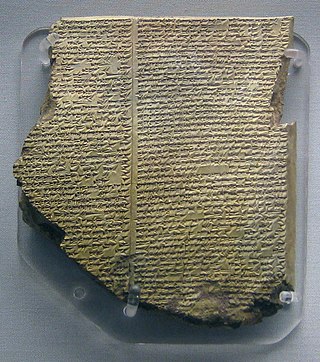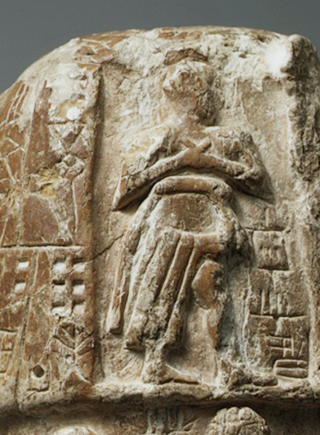Related Research Articles

Gilgamesh was a hero in ancient Mesopotamian mythology and the protagonist of the Epic of Gilgamesh, an epic poem written in Akkadian during the late 2nd millennium BC. He was possibly a historical king of the Sumerian city-state of Uruk, who was posthumously deified. His rule probably would have taken place sometime in the beginning of the Early Dynastic Period (Mesopotamia), c. 2900 – 2350 BC, though he became a major figure in Sumerian legend during the Third Dynasty of Ur.
Akkadian literature is the ancient literature written in the Akkadian language in Mesopotamia during the period spanning the Middle Bronze Age to the Iron Age.

The Epic of Gilgamesh is an epic poem from ancient Mesopotamia, and is regarded as the earliest surviving notable literature and the second oldest religious text, after the Pyramid Texts. The literary history of Gilgamesh begins with five Sumerian poems about Bilgamesh, king of Uruk, dating from the Third Dynasty of Ur. These independent stories were later used as source material for a combined epic in Akkadian. The first surviving version of this combined epic, known as the "Old Babylonian" version, dates back to the 18th century BC and is titled after its incipit, Shūtur eli sharrī. Only a few tablets of it have survived. The later Standard Babylonian version compiled by Sîn-lēqi-unninni dates from the 13th to the 10th centuries BC and bears the incipit Sha naqba īmuru. Approximately two-thirds of this longer, twelve-tablet version have been recovered. Some of the best copies were discovered in the library ruins of the 7th-century BC Assyrian king Ashurbanipal.

Humbaba, originally known as Ḫuwawa, was a figure in Mesopotamian mythology. The origin and meaning of his name are unknown. He was portrayed as an anthropomorphic figure comparable to an ogre, giant or demon. He is best known from myths focused on the hero Gilgamesh, including short compositions belonging to the curriculum of scribal schools, various version of the Epic of Gilgamesh, and additionally Hurrian and Hittite adaptations. He is invariably portrayed as the inhabitant or guardian of the cedar forest to which Gilgamesh ventures with his companion Enkidu. They clash, which leads to the death of Humbaba. The event typically causes the anger of the gods. He is also attested in other works of Mesopotamian literature. Multiple depictions of him have also been identified, including combat scenes and apotropaic clay heads.

Anzû, also known as dZû and Imdugud, is a lesser divinity or monster in several Mesopotamian religions. He was conceived by the pure waters of the Apsu and the wide Earth, or as son of Siris. Anzû was depicted as a massive bird who can breathe fire and water, although Anzû is alternately depicted as a lion-headed eagle.

Sîn-lēqi-unninni (Akkadian: 𒁹𒀭𒌍𒋾𒀀𒅆md30-TI-ER2) was a mašmaššu who lived in Mesopotamia, probably in the period between 1300 BC and 1000 BC. He is traditionally thought to have compiled the best-preserved version of the Epic of Gilgamesh. His name is listed in the text itself, which was unorthodox for works written in cuneiform. His version is known by its incipit, or first line "ša nagba īmuru" ("He who saw the deep" or "The one who saw the Abyss"). The extent to which his version is different from earlier texts is unknown; Andrew R. George argues that Sîn-lēqi-unninni "gave [The Epic of Gilgamesh] its final, fixed form". Tigay acknowledges that Sîn-lēqi-unninni shifted "Gilgamesh's greatness from deeds to the acquisition of knowledge". At time it was also known as "Gilgamesh series" (iškar Gilgāmeš).

Atra-Hasis is an 18th-century BCE Akkadian epic, recorded in various versions on clay tablets, named for its protagonist, Atrahasis. The Atra-Hasis tablets include both a creation myth and one of three surviving Babylonian flood myths. The name "Atra-Hasis" also appears, as king of Shuruppak in the times before a flood, on one of the Sumerian King Lists.

Lugalbanda was a deified Sumerian king of Uruk who, according to various sources of Mesopotamian literature, was the father of Gilgamesh. Early sources mention his consort Ninsun and his heroic deeds in an expedition to Aratta by King Enmerkar.
Siduri, or more accurately Šiduri (Shiduri), is a character in the Epic of Gilgamesh. She is described as an alewife. The oldest preserved version of the composition to contain the episode involving her leaves her nameless, and in the later standard edition compiled by Sîn-lēqi-unninni her name only appears in a single line. She is named Naḫmazulel or Naḫmizulen in the preserved fragments of Hurrian and Hittite translations. It has been proposed that her name in the standard edition is derived from an epithet applied to her by the Hurrian translator, šiduri, "young woman." An alternate proposal instead connects it with the Akkadian personal name Šī-dūrī, "she is my protection." In all versions of the myth in which she appears, she offers advice to the hero, but the exact contents of the passage vary. Possible existence of Biblical and Greek reflections of the Šiduri passage is a subject of scholarly debate.

The Gilgamesh flood myth is a flood myth in the Epic of Gilgamesh. Many scholars believe that the flood myth was added to Tablet XI in the "standard version" of the Gilgamesh Epic by an editor who used the flood story from the Epic of Atrahasis. A short reference to the flood myth is also present in the much older Sumerian Gilgamesh poems, from which the later Babylonian versions drew much of their inspiration and subject matter.
Jeremy Allen Black was a British Assyriologist and Sumerologist, founder of the online Electronic Text Corpus of Sumerian Literature.

Aga commonly known as Aga of Kish, was the twenty-third and last king in the first dynasty of Kish during the Early Dynastic I period. He is listed in the Sumerian King List and many sources as the son of Enmebaragesi. The Kishite king ruled the city at its peak, probably reaching beyond the territory of Kish, including Umma and Zabala.
The earliest record of a Sumerian creation myth, called The Eridu Genesis by historian Thorkild Jacobsen, is found on a single fragmentary tablet excavated in Nippur by the Expedition of the University of Pennsylvania in 1893, and first recognized by Arno Poebel in 1912. It is written in the Sumerian language and dated to around 1600 BCE. Other Sumerian creation myths from around this date are called the Barton Cylinder, the Debate between sheep and grain and the Debate between Winter and Summer, also found at Nippur.
In philology, a commentary is a line-by-line or even word-by-word explication usually attached to an edition of a text in the same or an accompanying volume. It may draw on methodologies of close reading and literary criticism, but its primary purpose is to elucidate the language of the text and the specific culture that produced it, both of which may be foreign to the reader. Such a commentary usually takes the form of footnotes, endnotes, or separate text cross-referenced by line, paragraph or page.

The Instructions of Shuruppak are a significant example of Sumerian wisdom literature. Wisdom literature, intended to teach proper piety, inculcate virtue, and preserve community standards, was common throughout the ancient Near East. The text is set in great antiquity by its incipit: "In those days, in those far remote times, in those nights, in those faraway nights, in those years, in those far remote years." The precepts are placed in the mouth of a king Šuruppak (SU.KUR.RUki), son of Ubara-Tutu. Ubara-Tutu is recorded in most extant copies of the Sumerian king list as being the final king of Sumer prior to the deluge. Ubara-tutu is briefly mentioned in tablet XI of the Epic of Gilgamesh. He is identified as the father of Utnapishtim, a character who is instructed by the god Ea to build a boat in order to survive the coming flood. Grouped with the other cuneiform tablets from Abu Salabikh, the Instructions date to the early third millennium BCE, being among the oldest surviving literature.

Wilfred George Lambert FBA was a historian and archaeologist, a specialist in Assyriology and Near Eastern Archaeology.
A lilu or lilû is a masculine Akkadian word for a spirit or demon.

The cuneiform sign tu, and for TU-(the Sumerogram, capital letter, in the Hittite language and other cuneiform texts, is a common-use syllabic sign for tu, and also with a syllabic use for "t", or "u". It is not a multi-use sign, with other alphabetic sub-varieties.
Stephanie Mary Dalley FSA is a British Assyriologist and scholar of the Ancient Near East. She has retired as a teaching Fellow from the Oriental Institute, Oxford. She is known for her publications of cuneiform texts and her investigation into the Hanging Gardens of Babylon, and her proposal that it was situated in Nineveh, and constructed during Sennacherib's rule.
References
- 1 2 3 4 5 "Andrew George | SOAS University of London - Academia.edu". soas.academia.edu. Retrieved 25 April 2019.
- 1 2 3 4 5 "Professor Andrew George". The British Academy. Retrieved 25 April 2019.
- 1 2 3 4 La epopeya de Gilgamesh. George, Andrew, Chueca, Fabián (1st ed.). [Barcelona]: Penguin Clásicos. 2015. ISBN 9788491050735. OCLC 933578180.
{{cite book}}: CS1 maint: others (link) - 1 2 3 "Professor Andrew R George | Staff | SOAS University of London". www.soas.ac.uk. Retrieved 25 April 2019.